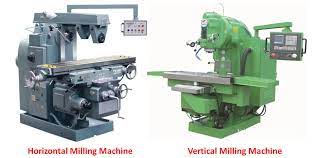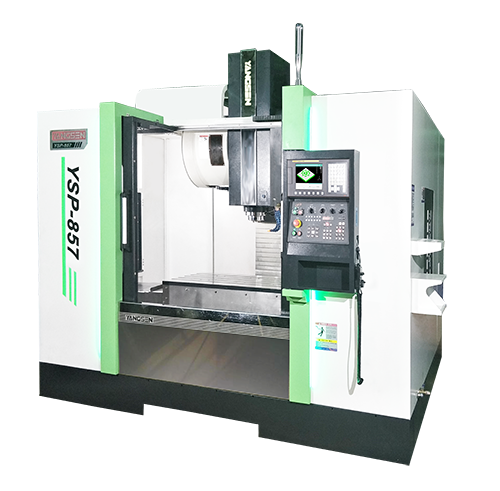Vertical milling is a machining process that uses specialized CNC (Computer Numerical Control) milling machines to shape or cut metal parts or other materials. It is an ideal method for creating complex shapes and working with intricate details. These CNC machines are able to move the cutting tool in vertical, horizontal, and rotational directions to produce the desired shape.
There are many different types of vertical milling machines available for use in a wide range of industries, from aerospace to medical device manufacturing. The most common type is the CNC vertical mill, which is designed to create precision parts with high accuracy and repeatability. This type of machine is capable of producing complex shapes such as gears, splines, shafts and other types of components. It is also used to create intricate details in castings or other metal parts.

The biggest difference between these two types of milling machines is the orientation of the spindle.
With vertical milling machines, the spindle features a vertical orientation. With horizontal milling machines, the spindle features a horizontal orientation.
Horizontal Milling Machines are mainly used for producing flat surfaces, cutting dovetails and making slots. Horizontal milling machines use cutters that are mounted on a horizontal arbor across the workpiece. The cutter rotates at high speeds and is fed into the material removing material in the form of chips.
Vertical Milling Machines are used for producing precision parts, cutting slots and drilling and boring holes. On a vertical milling machine, the spindle axis is aligned vertically making it possible to work with multi-angle surfaces. The cutter is held in an adjustable position on a rotating spindle which can be raised or lowered. The material is fed into the cutter at a controlled rate and the cutting tool removes excess material from the top of the workpiece. Vertical mills also offer features such as automated feed and speed control.
Horizontal vs Vertical Mill While there are many similarities between the two milling equipment, there are also many differences. We shall now look at the difference between them when it comes to their some important characteristics. Horizontal machining centers (HMCs) and vertical milling machines (VMCs) differ in several ways beyond their orientation alone.
When it comes to milling machines, there are two distinct types to consider: vertical and horizontal. The key difference between the two is the orientation of the spindle. In a horizontal milling machine, the spindle is oriented horizontally. It performs slicing operations along its axis while rotating in a clockwise direction. On the other hand, in a vertical milling machine, the spindle is oriented vertically and makes cuts perpendicular to its axis while rotating counterclockwise.
CNC (Computer Numerical Control) vertical milling machines are popular among industrial manufacturers due to their accuracy and precision when machining complex parts. This type of machine has an automated tool changer that can quickly switch between different cutting tools for greater efficiency in production. Another benefit of CNC vertical milling machines is that they can produce intricate parts with a high degree of accuracy and precision.
Horizontal milling machines are also useful for certain complex parts, such as curved surfaces or slots and grooves. This type of machine has an adjustable table which can be positioned to cut at various angles. They also feature a large cutting surface for greater efficiency in machining operations.
No matter what type of milling machine you choose, it’s important to consider the complexity and size of the project before making a final decision. Both vertical and horizontal milling machines offer unique advantages, so selecting one based on your specific needs is essential. If you need further guidance when choosing between these two types of machines, don’t hesitate to contact a professional for advice.
At the end of the day, both vertical and horizontal milling machines are great options to consider when it comes to machining complex parts. It all depends on your specific needs and preferences when selecting the right one. Both offer their own unique advantages that make them ideal for different projects. Keep this in mind as you decide which type is best for you.

In horizontal milling machines, the orientation of the spindle on which the cutting tool is fixed is horizontal. The rotary cutter digs into the surface and removes material from the workpiece while rotating about this horizontal axis. In a vertical mill, the tool is fixed in a vertical orientation. Featuring a setup similar to a bench drilling machine, these machines have a vertical arbour that holds as well as rotates the cutting tool plunging it deep into the workpiece material as needed.
Vertical milling is a type of machining that uses rotating cutters to produce parts with complex shapes and features. It is usually used in combination with horizontal and turret milling machines to create intricate designs. Vertical milling machines are typically larger than horizontal ones, as they have a larger cutting area for the spindle head to move in three directions. The spindle head can move in an up-and-down direction, as well as left to right and forward and backward. This allows for more complex shapes to be carved into the material. Vertical milling machines are often used for machining parts with complicated surfaces that require a high level of accuracy. They can also be used to create complex contours, as well as to drill and tap holes. Vertical milling machines are most commonly used in engineering, automotive, aerospace and defense industries, where precise parts with high levels of accuracy are needed.
Unlike horizontal milling machines, which are designed to cut materials horizontally, vertical mills feature a spindle that moves vertically. This allows them to produce cuts in any direction and from any angle. The cutting head of the machine is mounted on an arm which can be moved up and down or side-to-side depending on the requirement. Many modern vertical milling machines also feature CNC (Computer Numerical Control) technology, which allows them to be programmed with exact specifications and produce extremely precise parts.
Another type of mill used in industrial settings is the bed milling machine. This type of machine features a cutting head that can move up and down on a stationary bed, allowing it to make complex cuts in materials at various angles. Bed milling machines are often used when parts need to be produced that have a specific shape or profile. With CNC technology , the tools in some vertical machining centers can be manipulated on up to five axes for the fabrication of custom shapes, slots, holes, and details in three-dimensional parts.
Whether you choose a vertical milling machine, horizontal milling machine or bed milling machine, the right choice will depend on your particular needs and budget. Investing in a high-quality machine is essential for ensuring that the parts you produce are accurate and precise. With the right machine, you can ensure that all of your components have a perfect finish every time.

Vertical CNC milling machines are designed for precision cutting in the horizontal plane. They feature a vertical spindle, which allows the cutting tool to rotate and move up and down along its axis. This produces highly accurate cuts with minimal effort. The three main features of a vertical milling machine are:
1. Vertical spindle: The vertical spindle of the machine allows for precise cutting and drilling operations. It also allows for a range of angles to be cut, making it suitable for tasks such as producing angled slots, pockets, or holes.
2. Cutting tool rotation: The cutting tool rotates about its axis allowing for increased accuracy when performing intricate shapes or patterns.
3. Computer Numerical Control (CNC): The CNC enables the machine to be programmed and automatically execute commands, allowing for greater accuracy and repeatability of operations. This also reduces the time taken to complete tasks, making it more efficient than manual milling machines.
Overall, a vertical CNC milling machine offers a great deal of control and precision when it comes to cutting, drilling or other machining operations. With its combination of vertical spindle, cutting tool rotation, and CNC capabilities, this type of milling machine is ideal for most industrial applications.
Vertical grinding machinery is most commonly used where the cutter is seen in a vertical position. The tool press against the stationary workpiece and remove the material as you specified. Vertical milling is a two-dimensional process used for machining in industries.
Vertical milling machines are a type of turret milling machine, often found in manufacturing and industrial environments. This type of machine is used to shape and cut materials like wood, plastic, metal, and even stone. The vertical orientation of the spindle allows for greater accuracy when cutting larger items as it creates a more direct approach to material removal.
The vertical milling process involves rotating the object on an axis while using a cutting tool to remove excess material from the part being worked on. Generally, this type of machining process will result in parts that are more precise than those created by other machining processes such as horizontal milling or drilling. It also offers a greater degree of control over workpiece geometry compared to other processes.
In addition to industrial application, vertical milling machines can also be found in educational and hobbyist settings. They are an ideal tool for creating intricate parts with accurately machined surfaces or shapes that otherwise wouldn’t be possible with traditional manual tools. By virtue of their versatility and relatively low cost, they have become a popular piece of equipment among those who need precision machining capabilities in the shop or home workshop setting.
Vertical milling machines offer numerous advantages over other types of machinery; from being able to cut complicated shapes and designs to being more precise than alternative machining methods like horizontal milling or drilling. They are also easier to use as the user is generally required to spend less time adjusting the part setup as well as having more control over the end result. This makes them an invaluable piece of equipment for any industrial or hobbyist setting.
A vertical milling machine is an important tool used in a machine shop. It has a spindle that moves in the vertical direction, allowing for precise adjustments and deeper cuts than other types of milling machines. The bed of the machine can move both horizontally and vertically, creating multiple angles for intricate machining projects.
The cutting tools are also adjustable, allowing for greater control over the project. Additionally, a vertical milling machine has better chip evacuation compared to other types of machines due to its spindle orientation and motion. With this type of milling machine, chips can be easily removed from the workpiece without damaging it or the cutting tool.
Overall, a vertical milling machine is an essential tool for any machine shop, allowing for precise cuts and accurate machining projects. With its adjustable spindle and bed, it provides a great degree of control over the machining process. The added benefit of superior chip evacuation also makes it more efficient than other types of milling machines.